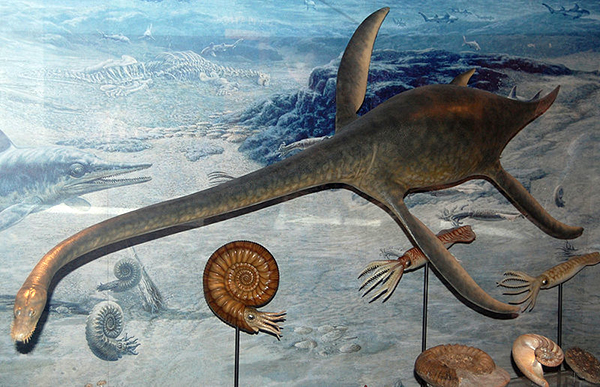
|
Search JoyZine with Google Site Search! |
Freshwater Plesiosaurs
Plesiosaurs were large marine reptiles with limbs shaped like flippers, very long necks and relatively small heads. The plesiosaurs that lived in the Eromanga Sea were mostly of an especially long-necked kind called elasmosaurs. Only two of the Australian plesiosaurs have official names (Crimoliasaurus maccoyi and Woolungosaurus glendowerensis). The most impressive fossils (“Dave” and the Addyman plesiosaur) are yet to be formally identified. Why do they have such long necks? No animal that lives in the sea now has such a long neck, so we have nothing we can really compare it to for clues. Some plesiosaurs had necks longer than their bodies, and their shape has often been described as a snake threaded through a turtle. Because of this odd shape, plesiosaurs were quite slow moving. But to catch fish they could move their head and neck rapidly, like a snake striking. Another possible use for the neck is the reverse of the way a giraffe feeds by reaching up. Plesiosaurs could have swum on the surface and reached down with their neck to search for food on the bottom. We know that plesiosaurs lived in shallow seas and had to breathe air, so this is a possibility. The problem with this idea is that plesiosaurs don’t have the teeth to crush things which could be gathered in this way, such as shellfish. What did they eat? They had curved teeth useful for catching fish, but not for chewing or crushing. It seems likely that they caught and ate the squid-like creatures called belemnites that existed at the time. Some plesiosaur fossils have stones preserved in the stomach area, showing that they swallowed stones (called gastroliths) to grind up food in their stomachs. Why are their fossils so valuable? In Australia plesiosaur fossils are sometimes made of precious opal. One 4 metre specimen from the Andamooka opal fields, now on display in the South Australian Museum, is made up of 36 kilograms of opal, worth up to a million dollars. It was kept in a bank vault for some years until it was sold to the museum for $25,000,000 by its discoverers, Molly and John Addyman. How did they breed? Like turtles, they probably came ashore to lay eggs on sandy beaches. No nests have ever been found but if they laid eggs, they had to lay them on land. There is no evidence at all that plesiosaurs gave birth to live young in the water. Did they dive deep? Probably not. Plesiosaur fossils are found in shallow seas and even freshwater lakes. They were able to dive but they fed near the surface and had no need to go deep. Being reptiles, they had to breathe air, so there would have had to be a good reason for them to leave the surface for a long time. Did they stick their heads up out of the water? They would have been capable of doing this, but again there seems to be no good reason why they should have done so. Perhaps they did in order to see whether they were close to land, but we just don’t know if their vision allowed them to see in this way. Rival males might have fought each other with their necks; both sexes might have courted each other with their heads out of the water. But at best, these are only educated guesses. |
